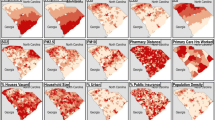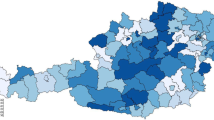Abstract
Policy makers increasingly rely on hospital competition to incentivize patients to choose high-value care. Amongst all possible drivers, the travel distance without any doubt is one of the most important. In this paper we propose the use of a spatial Bayesian hierarchical model to assess the impact of distance on the number of patient admissions in hospitals, and thereby, compare hospital attractiveness. To this aim a MCMC sampler has been designed. We apply our methodology to patient admissions for asthma in four hospitals located in the Hérault department of France. Results indicate that the most attractive hospital is the CHU Montpellier.


Similar content being viewed by others
References
Agarwal, D.K., Gelfand, A.E., Citron-Pousty, S.: Zero-inflated models with application to spatial count data. Environ. Ecol. Stat. 9(4), 341–355 (2002)
Aho, K.: asbio: a collection of statistical tools for biologists. R Package Version 1. 1–5 (2015)
Banerjee, S., Carlin, B., Gelfand, A.: Hierarchical modeling and analysis for spatial statistics. Chapman & Hall/CRC, New York (2004)
Berger, J.O., De Oliveira, V., Sansó, B.: Objective bayesian analysis of spatially correlated data. J. Am. Stat. Assoc. 96(456), 1361–1374 (2001)
Chevreul, K., Durand-Zaleski, I., Bahrami, S., Hernández-Quevedo, C., Mladovsky, P.: Health system review. Erasmus 12, 93–103 (2010)
Cohen, A.C.: Estimation in mixtures of discrete distributions. Statistical Pub. Society (1963)
Davison, A., Padoan, S., Ribatet, M.: Statistical modelling of spatial extremes. Stat. Sci. 7(2), 161–186 (2012)
Gelfand, A.E., Smith, A.F.: Sampling-based approaches to calculating marginal densities. J. Am. Stat. Assoc. 85(410), 398–409 (1990)
Gelman, A., Carlin, J.B., Stern, H.S., Rubin, D.B.: Bayesian data analysis. In: Texts in Statistical Science Series (2004)
Greene, W.H.: Accounting for excess zeros and sample selection in poisson and negative binomial regression models (1994)
Johnson, N.L., Kotz, S.: Distributions in Statistics. Wiley, Hoboken (1969)
Jung, K., Feldman, R., Scanlon, D.: Where would you go for your next hospitalization? J. Health Econ. 30(4), 832–841 (2011)
Lambert, D.: Zero-inflated poisson regression, with an application to defects in manufacturing. Technometrics 34(1), 1–14 (1992)
Propper, C., Leckie, G.: Increasing competition between providers in health care markets: the economic evidence (2011)
R Core Team: R: A Language and Environment for Statistical Computing. R Foundation for Statistical Computing, Vienna (2017)
Sang, H., Gelfand, A.: Continuous spatial process models for spatial extreme values. J. Agric. Biol. Environ. Stat. 15(1), 49–65 (2010)
Spiegelhalter, D.J., Best, N.G., Carlin, B.P., Van Der Linde, A.: Bayesian measures of model complexity and fit. J. R. Stat. Soc. Ser. B (Stat. Methodol.) 64(4), 583–639 (2002)
Varkevisser, M., van der Geest, S.A., Schut, F.T.: Assessing hospital competition when prices don’t matter to patients: the use of time-elasticities. Int. J. Health Care Finance Econ. 10(1), 43–60 (2010)
Victoor, A., Delnoij, D.M., Friele, R.D., Rademakers, J.J.: Determinants of patient choice of healthcare providers: a scoping review. BMC Health Serv. Res. 12(1), 272 (2012)
Zhang, H.: Inconsistent estimation and asymptotically equal interpolations in model-based geostatistics. J. Am. Stat. Assoc. 99(465), 250–261 (2004)
Author information
Authors and Affiliations
Corresponding author
Ethics declarations
Conflict of interest
We, the authors, declare that we have no conflicts of interest.
Human and animals rights
That this article does not contain any studies with human participants or animals performed by any of us.
Appendix A
Appendix A
In this section, we give the derivation of conditional parameters distributions for the ZIP model. To obtain the derivation for the ZINB model, the distributions used in the ZIP model have to be replaced by those used in the ZINB model. As a reminder, (a) Bayes formula is
where \(\pi (\theta \mid x)\) is called the posterior distribution, \(\pi (\theta )\) the prior distribution and \(\pi (x\mid \theta )\), the likelihood. b) and the prior distributions used in this case study for the ZIP model are
Let’s call \(\pi \{y({\mathbf {x}}),\theta ,\lambda ({\mathbf {x}}),\beta _0,\beta _1,\tau ,\omega \}\) (with \(\lambda ({\mathbf {x}})\), \(\beta _0\), \(\beta _1\), \(\tau\) and \(\omega\) as defined in Sect. 4), the joint distribution for model parameters and the data. Using the definition of conditional probabilities and assuming parameters independence within their prior distributions, we show that
Then using Bayes formula and Eq. 4, we derive the conditional distributions
which have to be used in the Gibbs sampling. To obtain the explicit form of these distributions, every term in the right members has to be replaced by its mathematical expression. Thus, let’s denote \(n_{1,h}\) the number of locations where we count zero stays for a hospital h and \(n_{2,h}\) the number of locations where we have at least one stay in the hospital. From Eq. 1, Sect. 3.1,
and by definition in Sect. 3.2
By replacing every term by its explicit expression, we obtain
Rights and permissions
About this article
Cite this article
Saley, I., Molinari, N. & Ribatet, M. Comparing the spatial attractiveness of hospitals using zero-inflated spatial models. Health Serv Outcomes Res Method 18, 128–141 (2018). https://doi.org/10.1007/s10742-018-0181-8
Received:
Revised:
Accepted:
Published:
Issue Date:
DOI: https://doi.org/10.1007/s10742-018-0181-8




